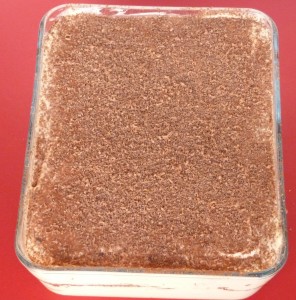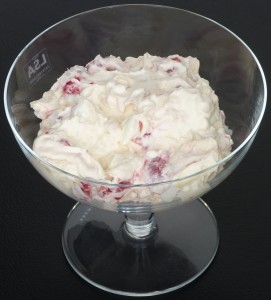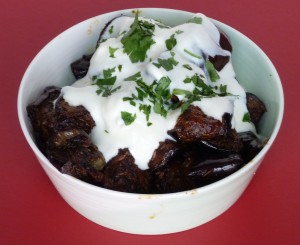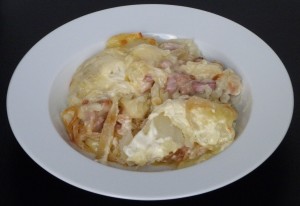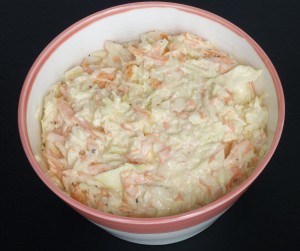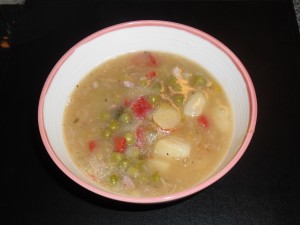Tuesday 30 June 2015
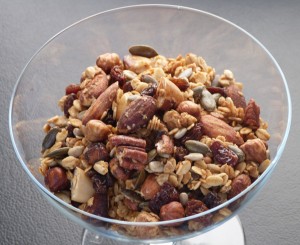
Granola
Most people think of granola as something healthy to have for breakfast. Personally, I see it more as a nice, sweet-ish, tasty treat for those little moments of temptation that cannot be resisted – not at all without sweetness, but infinitely better than almost anything you could think of (e.g sweets, cakes, chocolate, etc.) . . . . .
. . . . . . . . that is, of course, if you make it the way I do – big problem with most commercially available cereals (including muesli and granola) is that they are over-sweetened with far too much added sugar. The big advantage of making your own is that you can put into as much or as little of anything you like. I tend to put a little honey and maple syrup into granola and leave it at that, so that it is sweetened, but only just.
As far as recipes go, there would be as many as those who make it, none of them right and none of them wrong. All you need are guidelines for the proportions of the ingredients and even those may be almost infinitely varied.
So have a go using the proportions in the recipe then next time you do it, adjust to suit your own taste accordingly.
Monday 29 June 2015
It’s funny how things work out!
We were going to a large event down in Dorset this weekend. Everything had been booked for months but a final check of the hotel booking showed that we had a twin room – not our favourite sleeping arrangement – and so I suggested a quick call to see if we could change it to a double. Imagine our shock to find that the booking had apparently been cancelled by hotels.com about a month after we made it and that they, in their infinite wisdom, had failed to inform us. They seemed completely unconcerned by this and reassured us repeatedly, as if it made any difference, that we would not be charged for the accommodation.
Well, when there is a major event on in somewhere like rural Dorset, hotel rooms go like hot cakes and so, in a state of near panic at suddenly finding we had nowhere to stay over the weekend, we started frantically ringing hotels and B&Bs. Amazingly, and against all the odds, we found somewhere – a lovely B&B just outside Wareham where our original hotel was.
Much relieved, we set off on our journey down there. On arrival we ventured into Wareham to check out some local restaurants and made a booking for the Saturday evening. On the way back to our B&B we passed an inauspicious looking restaurant which said above the door ‘The 29029 Restaurant – Contemporary Indian and Nepalese Cuisine’. As it was close enough to walk from our accommodation, we decided to do just that so we could enjoy a glass of wine with our meal.
It’s odd how sometimes the outside of a restaurant gives no clue as to the delights that lie within. The wooden exterior might reasonably be described as a large wooden shack. We were pleasantly surprised to find a) that it was indeed open, and b) that the inside was splendidly opulent – a kind of culinary ‘tardis’.
Pleasant surprise c) of course was the menu – most Asian restaurants have the usual suspects, i.e. the kormas, madrases, vindaloos, etc. plus a few specials. The 29029 has a menu full of specials with the usual suspects added as a footnote if you really want them, and what specials they are!
We had delightful little crab cakes and mo-mo for starters. Mo-mo are a fusion of Chinese dim-sum and Asian spiced meat so effectively tiny Indian dumplings. I had seen them mentioned in a recent food program on TV but had never before encountered them in a restaurant.
Main courses were a divine Avocado-Stuffed Roasted Chicken Mosala and King Prawn Delight – 5 gi-normous king prawns in a Rajastani sauce flavoured with saffron and almonds and served with Lemon Rice and Parsnip shavings. Absolutely stuffed, we didn’t even dare look at the dessert menu.
They’ve been there a few months and business they say is good. Trust me, it would be well worth the trip to Dorset just to eat there.
As an aside, the taxi we took to our event the next morning cost a whopping £40 – a bit high we thought for a 5-6 mile journey. However, when the return journey cost only £20 we asked our driver (same cab company different driver) why the morning’s run would have cost twice as much, and he said we had been robbed and very graciously refused to take any money from us, saying he would get his £20 from the other driver. Full marks to him and many thanks.
We ate on Saturday evening in a lovely gastro-pub called ‘The Old Granary’ overlooking the river Frome (large prawns in garlic and fish and chips served in paper). Also very good but without wishing them any disrespect, nothing like the same dining experience as Friday in The 29029 (which incidentally is the height of Mount Everest in feet in case you were wondering.)
So there you go – they say every cloud has a silver lining and if Hotels.com hadn’t fouled up with our booking, we would never have discovered The 29029, but not even that would be enough to persuade us to use Hotels,com again.
Thursday 25 June 2015
I went to a reception kind of thing last night – too many people in too small a space with no sound deadening so that every conversation roared off the ceiling like a waterfall. There was background music playing and I was just about to ask them to turn it down when they turned it up – apparently the organisers had requested it!
So unwilling to endanger my vocal chords by yelling inane platitudes at any more people than necessary, I took over a small corner of the bar and got on with my crossword as I waited for the speeches, which were after all the point of the event.
Almost everyone was male; almost everyone ridiculously young (or looked it!); and almost everyone looked marginally less interesting than a stone on a beach.
A more mature-looking man (well, the grey, thinning hair could have been a wig!) came up to the bar next to me and ordered a drink. In the way that one does at such events, I said, “Hello”.
He asked me what I did so I said I build sophisticated automation systems in Microsoft Excel using Visual Basic (VBA) with Access databases behind them, adding “and you?”
He replied with a flourish, “I am an Excel guru!” “Wow!” I said, “does that mean you’re a consultant or the like?” He replied that he was but spent most of his time just writing programs, and then he left, presumably finding me about as interesting as I did everyone else, or maybe I just represented the competition.
I had previously noticed an Asian looking lady in a white jacket wandering around looking nervously lost (though not sure how one could be in such a small space). The next thing I knew, she came up to the bar next to me, still looking nervous and lost.
My appetite for mild conversation whetted, I asked if she was OK, adding that I was asking because she looked troubled. She said she was. I asked what she dd. She said, in a very quiet voice so it was difficult to hear, that she was the Microsoft Marketing Manager whose event it was.
I asked hesitatingly whether in that case she should really be wandering around looking lost, or whether she should be rather strutting around as if she owned the place. She smiled, left and carried on wandering around still looking lost.
A couple more clues later (in the crossword), and I had another visitation – this time from a delightful young woman who informed me that she was the only black person in the room and asked me why I thought that might be, adding that she found the testosterone flying around the room quite overwhelming. I pointed out that were a number of Asians and some Orientals but had to agree that she indeed appeared to be the only Afro-Caribbean.
She told me she was a stand-up comic looking for material. It struck me that she could well be in the right place. A brief life history later (hers, not mine) and she went off in the pursuit of material.
My final visitor was a man who turned out to be a financial planning consultant. One has to wonder how they market these events.
When the speeches did finally materialise, we could not actually see the presenters as they had not thought to put in any kind of staging to raise them above those standing next to them, thus rendering them visible, and we could not really hear them as the PA wasn’t up to the job, so all in all, a bit of a waste of time.
Anyway, in case you’re wondering what all this has to do with food, the answer is nothing, which is precisely what we were given to eat, despite the invitation offering free food and drink. Alcohol there was aplenty but nothing to soak it up, which struck me as somewhat irresponsible given that all these people had come straight from work and presumably had not eaten.
Normal service will be resumed tomorrow
Wednesday 24 June 2015
In the way that one does, I was chatting to my hairdresser today about the Indian meal I cooked on Friday evening, and she told me she doesn’t cook Indian food – wouldn’t know how to begin!
I would imagine that’s a pretty common view – my expectation would be that many people are a little nervous of doing it, believing it to be difficult, and possibly afraid of getting it wrong. Many others possibly do curry by making a ‘normal’ stew of some kind and just stirring in some curry powder, which is fair enough.
But I would urge anyone with a taste for spicy food to have a go as it is incredibly satisfying to get it right. I shall return to the wherewithal for cooking Indian food in a future blog, but for now, do have a look at the recipe for using the MDH spice mix (or equivalent) and give it a go – I promise you will not be disappointed!
More on this subject later!
Tuesday 23 June 2015
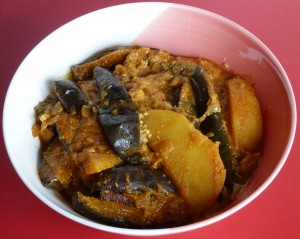
Aubergine Curry Chettinad
Still working my way through Friday night’s recipes and still with aubergine, generally hugely under-rated in the west as an ingredient in Asian food. Most restaurants will have only a Brinjal Bhaji which does little justice to this wonderful vegetable (actually it’s apparently technically a fruit!)
Aubergines are native to the Indian subcontinent and are known as Baingan in the south. The other word Brinjal rather bizarrely comes from the Portuguese (big influence in Goa – check out Vindaloo!) Beringela (like Spanish Berenjena).
Chettinad is a village in the Tamil Nadu region (down at the bottom of the pointy bit on the right next to Kerala which is on the left) and well known for its excellent cuisine.
The area is particularly famous for chicken and crab dishes but I rather like this aubergine dish which is substantial enough for a main course.
Although it contains no meat, don’t think of it as only fit for vegetarians – it’s a lovely dish in its own right to be enjoyed by anyone.
Monday 22 June 2015
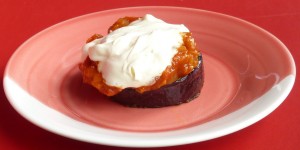
Badin Jaan
Badin Jaan is the signature dish of the Dum Pukht, one of the top restaurants in Mumbai. It is served as a starter and if you can stack it a bit better than I did for my photo, looks very elegant.
I like it because a) it’s delicious, b) it’s vegetarian but so nice that your guests would hardly notice, no matter how much they like their meat, c) you don’t get it in any restaurants that I know of in the UK so has a bit of cachet, and d) it’s incredibly simple.
Before anyone asks, I have never eaten in the Dum Pukht, or even been to Mumbai. I came across this dish on a cookery program in which an American TV chef went to India and, in the bizarre way everyone seems to these days, became embroiled in one of these odd cook-off type competitions so beloved of indifferent cookery programs. The head chef at Dum Pukht made Badin Jaan while the American made a rather ordinary-looking aubergine-based pasta dish, and became quite incensed when he lost, seeming to just not understand India and its food.
I liked the look of the dish, found a recipe on the internet, tried it, and was not disappointed. It now starts nearly every Indian meal we eat at home with guests.
Sunday 21 June 2015
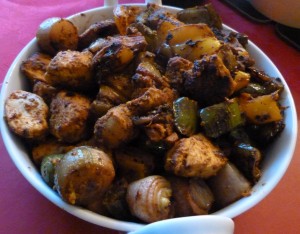
Chicken Shashlik
Apologies if anyone thought this Blog had, like Napoleon 200 years before, met its Waterloo on Thursday – just have not been able to get time to sit at my PC and write anything.
On Friday evening we had friends coming for dinner and I spent the whole day cooking; I had visions of being finished by mid-afternoon and then spending some time photographing and writing about what I had done, but, alas, it was not to be. The cooking went right to the wire.
Managed to grab a few quick mugshots of some of the dishes just before we set about them but that’s about it.
My two favourite cooking ethnicities are Indian and Spanish, not necessarily in that order and not necessarily not. Friday evening was to be Indian – more of Spanish later. The plan was
The lamb curry Nalli Gosht, which I had not previously made, is meant to be made with lamb shaNKS but as I had some lamb chuNKS in the freezer I decided that that was close enough and so used them, following the same recipe.
The only other item I had not cooked before was the kulfi. Ordinarily I wouldn’t bother with a dessert but recipe success with condensed milk-based, no churn ice cream led me to want to have a go. Much simpler than I expected and, if I’m honest, much nicer, so I guess that answers the age-old question, “What’s it all about, Kulfi?”
When I plan a meal of this type, logistics is paramount – looking at the stages of each dish and planning when to do each so that the whole thing comes together at the end. For example, I started the lamb and chicken marinating on Thursday evening and put them in the fridge overnight.
On Friday morning, I simmered the milks for the kulfi with cardamoms so they had plenty of time to cool before the next stage; made a mint dip and red onion salad (kachoomber) to allow them to mature; made the naan dough so it could rise splendidly; started soaking the rice; and made the tomato sauce for the Badin Jaan.
As soon as the milk mixture was cool enough, I made the kulfi as it needs several hours to freeze.
Thereafter it was jus a case of knocking out each dish, getting it to a point where it could be re-heated at the last minute prior to serving. It helps to have lots of pans (leaving each partly completed dish in its pan till ready for the next stage of cooking) and small-to-medium-sized woks are best for this kind of food.
it will not surprise those that know me to learn that I use a spreadsheet for the logistics planning as I find it easier, but if you’re more comfortable with bits of paper or gifted enough to do it all in your head, then do it how it works best for you, but it is the secret of this kind of cooking.
Off soon to my favourite Chinese restaurant to meet up with the family and celebrate Father’s Day so no cooking today!
Thursday 18 June 2015
My other great passion (apart from food) is history and it’s not often one gets the chance to combine the two but today’s the day.
It may (or may not) have escaped your notice that on this day 200 years ago in 1815 near the village of Waterloo in Belgium, an army under the Duke Of Wellington defeated the mighty French army under none other than Napoleon Bonaparte, thereby sowing the seeds for Europe as we know it today.
So first things first, Happy Birthday, Waterloo!
Tonight’s supper is a dish supposedly created during the battle of Marengo in Italy on June 14, 1800. It was an important battle for Napoleon and led to the Austrians being driven out of Italy Legend has it that he refused to eat before the battle and came off the battlefield halfway through, starving.
Apparently his chef created this dish from the only ingredients he was able to forage that day: a chicken, some bread, oil, garlic, tomatoes, eggs and, of all things, crayfish. Napoleon devoured it hungrily, and then returned to the field to win the day triumphantly. Being somewhat superstitious he came to associate this dish with victory, and supposedly insisted on having it prepared whenever he went into battle thereafter. It is thus highly likely that he ate it on 17th June 1815, the night before Waterloo.
Napoleon was anything but a bon viveur and had little time for haute cuisine, eating most meals on the fly. He suffered throughout his whole life from notoriously bad digestion. However he liked eating this dish served on a bed of grilled bread and topped with a fried egg. Nowadays it is usually served without the bread, egg . . . . . . . . . . . . . or crayfish.
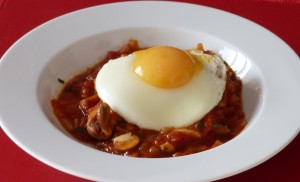
Chicken Marengo
As a dish, it’s OK, but doesn’t do much credit to Napoleon’s chef. Most reasonable cooks, faced with the same ingredients could well come up with something similar so it gives away nothing of the potential talent of the chef.
On the other hand if the requirement is to feed a hungry soldier, it’s spot-on and I guess that part of being a clever chef is to know your customer and cook accordingly.
Vive l’Empereur!
Wednesday 17 June 2015
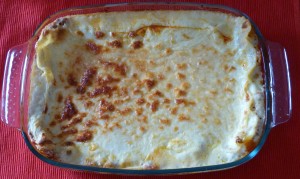
Lasagna
I hope no-one has been waiting for this lasagne recipe promised since Monday, but if so, must be pretty hungry by now!
Lasagna is a perfect example of food componentisation – you take a few things that you’ve made previously (I.e. Bolognese sauce and Béchamel Sauce) and assemble them into a meal.
The most important thing to remember about lasagna is that it is a pasta dish not a meat dish and like all pasta dishes, the pasta is what matters. so in assembling it into your dish, make the layers of Bolognese as thin as you can so you get more layers of pasta, and you should be aiming for 4, 5 or even 6 layers.
Finish with a top layer of pasta. It’s quite a nice effect to daub little nuggets of mozzarella over the top, before adding the béchamel sauce and parmesan.
When cooked it can rapidly become a family favourite and made like this, is infinitely cheaper (and nicer) than any shop-bought version. If you have any left over, it freezes really well.
Tuesday 16 June 2015
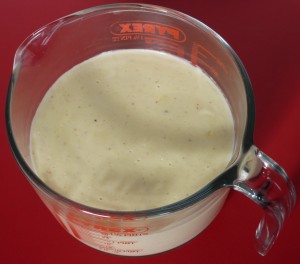
Béchamel Sauce
The second component for a Lasagna is a lovely, creamy, white sauce. It’s amazing how many people buy this ready-made in supermarkets when it’s so easy and quick, not to mention CHEAP, to make. And you can flavour it just the way you want it rather than the way they made it.
I normally just add a pinch of nutmeg to flavour it but by all means do it with onion, cloves and bay leaf (see Flavourings at the end of the recipe). I also like to add something to make it a bit creamier and more velvety such a carton of ricotta cheese or mascarpone. There are others, I know, who prefer to use a full cheese sauce.
This needs to be made just before you make the lasagne so it can be hot when poured on the top.
I’m hoping you can’t wait until tomorrow when the rest of the Lasagna recipe will be revealed!
Monday 15 June 2015
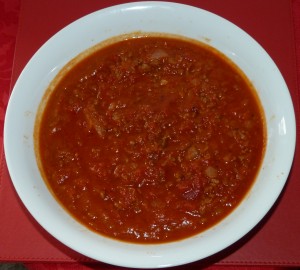
Bolognese Sauce
One day last week my friend Olivera sent me a text message asking me to remind her how I make lasagna (I think I’m right in saying that the dish is lasagnA with an ‘a’ but the pasta sheets are lasagnE with an ‘e’, the latter being in Italian the plural of the former. So I’m sure that’s clear as mud to everyone).
Lasagna is actually a really interesting dish which combines a couple of basic components which, once mastered, give access to a great many lovely dishes.
The first thing needed is a Bolognese Sauce. As usual there are probably as many recipes for this as there are people who make it, and while there is no right or wrong way, merely different ways, some of them quite complex and involved, I like this method because of its simplicity.
I came across the recipe on an early program by Antonio Carluccio and he assured us, the viewers, that this is an authentic Bolognese Sauce, and I guess he should know!
One can use beef mince, pork mince or any combination of the two but he cautions against over-flavouring with too many other ingredients. The single most important requirement is slow, gentle simmering for at least 3 hours.
That’s not to say that if you only cook it for half an hour it will be disgusting, because it is after all only mince, which cooks really quickly, and if half an hour is all you’ve got then so be it, but the secret of really good Italian cooking is thinking like a ‘nonna‘ or grandmother (not that I’m either Italian or a grandmother, or have/had a grandmother that is Italian).
These wonderful ladies can spend all day preparing a meal for the family and it’s not the ingredients that make their food taste so good (although it helps), it’s the love, care and attention to detail that goes into it.
An Italian friend of mine who spent a number of years when young living in Sicily with his nonna told me he cannot now eat Minestrone Soup as any he could now get would simply pale into insignificance when compared to his nonna’s magnum opus.
She would spend ages lovingly grating onions by hand, then cooking each vegetable individually (none of this chucking it all in one pot) and so on.
So to get the best from Italian food, just give it that most precious of ingredients, time!
Something else I’ve noticed when in Italy is that this kind of meat sauce is usually a lot runnier than we would typically make it in the UK so I’ve upped the quantity of tomatoes in my version of the recipe to achieve this.
Once you’ve made this you can have it with some pasta (but in Italy apparently, NEVER spaghetti). or save it for a couple of days to go into the lasagna I’ll be telling you about on Wednesday.
Sunday 14 June 2015
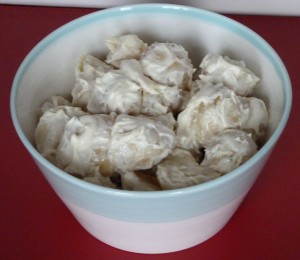
Potato Salad
“Now, ” you might say, “Why would anyone need or want a recipe for potato salad? Surely you just take a load of cooked potatoes and smother them in mayonnaise?”
Well, in a sense, I guess you do and if you’ve never known anything else, would probably think that’s OK, but with just a little more imagination, it can be made wonderful.
I often wonder what the mayonnaise brigade make of a shop-bought or professionally-made potato salad, which is always cleaner tasting and whiter than one with just mayo. Its amazing the difference a drop of white wine vinegar and crème fraîche makes.

Greek Salad
In the good old days a Greek salad was just cucumber, tomato and feta with a few olives scattered over, served with lashings of oil and vinegar (and probably still is in the small villages).
In these days of continuing affluence it is increasingly normal to find additional ingredients like onion and peppers. Sometimes lettuce is added but it could be contended that the moment lettuce is added, the salad ceases to be Greek.
The best fresh salad I know is in a restaurant near the Mikrolimano (literally Little Harbour and it is just like the kind of little harbour you find on the islands) in Athens called ‘Doumbareis’ (assuming that in these days of Greek austerity it is still there!) which presents it as an ‘English’ salad (rather than their Greek variant) and uses ultra crisp gem lettuce as its basis, along with all the typical Greek components excepting feta.
And if you get it right, you can say it is a ‘feta-compli’
By the way, for those who might be interested, Porsche took 1st and 2nd places in the Le Mans 24 Hours
Saturday 13 June 2015
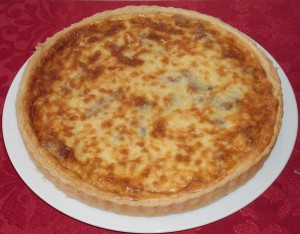
Quiche Lorraine
Second weekend in June means only one thing for me – it’s Le Mans!
If you don’t know, the Le mans 24 Hours is a motor race that starts on Saturday afternoon and ends on Sunday afternoon, 24 hours later, so winning is not just about being the fastest, it’s also about being able to keep going. So as you go to bed on Saturday night it’s worth thinking about these drivers hurtling on into the night. Actually, they don’t drive for 24 hours as each team has 3 or 4 drivers (pilotes in French) who take it in turns to keep their machines going.
It’s the only sporting event I watch on TV in any year and because of the wonderfully memorable weekends I spent there many years ago, for me it says picnic – actually not just picnic, but French picnic. While that means French bread and pâté/cheese, it also means that most French of picnic fare, Quiche Lorraine (not, as some people apparently think, pronounced Quickie!)
It’s been my intention to make one of these for as long as I can remember so I thought that today should be the day!
This recipe originated, I believe, with Rachel Khoo and I can’t believe how easy it was, not to mention how wonderfully delicious.
As I write the cars have been going for about 8½ hours, the fastest of them getting up to about 330 kph in places so the race is certainly no picnic.
Friday 12 June 2015
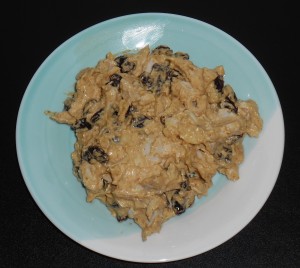
Coronation Chicken
While I have for a long time now cooked all my own food, the decision on what to eat on any given day was always purely random and based on a whim, often something that took my eye in the supermarket or even what was reduced or on offer.
But recently I decided to take a more strategic approach to what I eat, for example not having red meat more than once a week (and that includes things like mince and sausages). So the diet needs to be mainly chicken, fish and/or vegetables.
Eating lots of chicken is all very well but while plain roast or grilled chicken can get a bit tedious after a while, there are many different and interesting ways to prepare it with each new recipe seemingly more exciting than the last. While, like everyone, I have a few ‘staples’ – dishes I cook on a regular basis – it is always fun and interesting to try something new.
When you buy chicken, you should always buy a whole bird. The price of chicken virtually doubles every time someone in a shop touches it, so while a whole chicken might be £x per kg, chicken breast might be £2x and diced, probably £3x or even £4x. Since every chicken, by definition, includes 2 breasts, and the whole bird costs the same as (or even less than) 2 breasts, that means you get everything else for free, i.e. 2 legs, 2 wings and a carcase, all of which can be cooked straight away or frozen for later.
Never throw the carcase away (whether raw or roasted); pop it in a pot, cover it with cold water and boil it for an hour or so, turning and mashing it down now and again so that as much of it as possible is in the water. When cooked, drain it thoroughly and glean as much meat as you can from the carcase. This can be the basis of a free meal – soup, pie, etc. and chicken stock freezes really well.
If you don’t like touching the raw chicken, wear rubber gloves, but whether or not you do, ALWAYS wash thoroughly afterwards as raw chicken may contain some quite harmful bacteria.
I try to have a roast chicken in the fridge at all times as it makes for easy lunching and healthy snacking, should the need arise.
On the subject of lunching, one of my favourites is Coronation Chicken. First made in 1953 for the Queen’s Coronation (never!), the most surprising thing I find about that is the availability of curry powder in 1953!
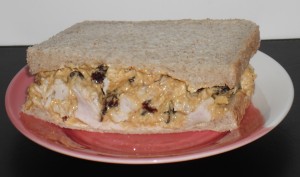
Coronation Chicken is something I’ve made for a long time now with my recipe variyng over time and this is its present manifestation. I love it for lunch in a sandwich but it is equally wonderful as a salad, and particularly good heaped on top of half an avocado. Cut everything very finely and use it to fill vol au vents or little pastry cases for beautiful canapés, or pile it on thinly sliced French bread for a lovely tapas dish.
I used to travel a lot on business and, in particular spent about a year to-ing and fro-ing to Wisconsin in the USA. During one visit to Milwaukee, I had occasion to spend a pleasant summer weekend and was invited to a barbecue on the Sunday. As is my wont, I decided to make something to bring along and decided on Coronation Chicken on the basis that no-one else would bring it and I should be able to obtain everything I needed locally.
While there, one of my colleagues commented to me, ”Ken, the chicken salad is awesome!”. I was surprised because I’ve never really thought of Coronation Chicken as just ‘chicken salad’, but I guess it is really.
Again, simplicity itself to make (with a few specialist ingredients) and a sure-fire hit every time.
Thursday 11 June 2015
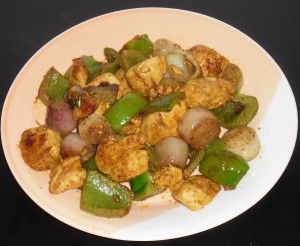
Chicken Shashlik
Chicken shashlik is a great dish if you fancy something a bit spicy but are trying to lose weight – lots of taste and highly satisfying, but very low in carbohydrates and fat, being just meat and vegetables. It is also incredibly easy
Shashlik is actually just a Middle Eastern/Eastern European word meaning skewer ( like Shish in Turkish or Souvla in Greek) and traditionally the meat and vegetables would be threaded onto skewers and cooked on the barbecue (always an option) but I find it more convenient to use a hot frying pan for everyday use.
This recipe is based on what is served up in Asian restaurants, often sizzling on a hot plate and generally either chicken or lamb.
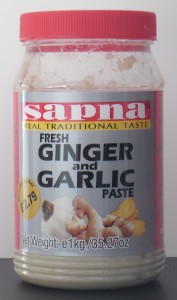
Incidentally, when cooking in this way, I tend to use ginger/garlic paste (above) instead of the fresh products, which I would normally use. My understanding is that this is what is used in Asian homes (they certainly seem to sell enough in Asian shops) and if it’s good enough for them, then it’s good enough for me. Use roughly a heaped teaspoonful per clove of garlic and cm of ginger.
Ginger paste and ginger paste are also available separately and useful standbys, although if only one is required I would tend to use the real thing.
Wednesday 10 June 2015
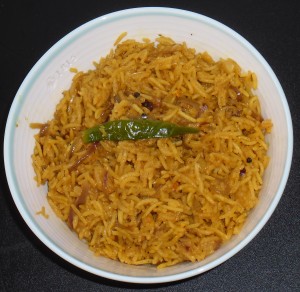
Pulao rice
If, like me, your impression of pulao rice in a restaurant is that it’s basically boiled rice flecked with a bit of food colouring, for which you pay a substantial premium. then you need to try this out.
Imagine for a moment rice so good that you just want to shovel it into your mouth as fast as you can, ignoring everything else on the table – that’s MY kind of pulao rice; that’s this kind of pulao rice; that’s a proper pulao rice.
Coming from Kashmir in the north of India where breads are the more usual staple, it is flavoured with the delicate fragrances of cinnamon, cardamoms and cloves and lightly coloured with turmeric (saffron infused in a little milk is better but MUCH more expensive – did you know that saffron is the most expensive substance on earth? If you buy a typical supermarket ‘jar’ containing an almost unbelievable 0.4 gm for, say, £3.99 that works out at £99.75 for 10 gm or a whopping £9,975 per kg (Yes, that’s just £25 short of £10,000 per kg!) . There are cheaper brands and it certainly gets much cheaper if you buy larger quantities; on eBay you can for example buy 12g for£18.99 which makes it by comparison an absolute snip at a mere £1,582.50 per kg).
Anyway, as I said, saffron is better but you may need a second mortgage!
Most important part of making this is thoroughly washing/soaking the rice to remove excess starch so that, when cooked, it is soft and loose.
You can also add nuts (e.g. cashews) and /or raisins to it, but if you do, just make sure you remove all the whole spices first as these are not so nice if bitten into.
Do try this and you’ll never have boiled rice with curry again!
Tuesday 9 June 2015
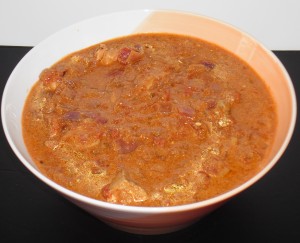
Chicken Curry (Quick)
A couple of years ago I was visiting an Indian friend when she invited me to stay for dinner. Well, you don’t often get the chance to have a home-cooked, ‘proper’ Indian curry so I readily accepted.
It was fabulous and I asked her if she would mind letting me have the recipe. Imagine my shock when she took a small blue packet off a shelf and said that the recipe was on the back of the packet! This was my first introduction to packet curry mixes.
Many years ago I had shared a flat with a couple of Indians who taught me how to make a really good, albeit basic, curry using garlic, ginger, ground coriander, cumin, turmeric, chilli, etc. From that I had developed a passionate interest in food from the Indian sub-continent and now make many different dishes from many different regions and they are as different from each other as, say, Spanish food is from Italian – they use many of the same ingredients but they assemble it quite differently.
My impression had been that all Asians cooked their own curries from scratch, mixing their own spices so this packet spice mix was a bit of a revelation to me.
Anyway I decided that I must have some. It wasn’t hard to find and in fact many supermarkets now stock this kind of product. If you can’t find it there, then your local Asian grocer will have this or something similar. Whatever you buy, just follow the instructions on the packet. My recipe is just that – the instructions off the MDH packet in a size that can be read without a magnifying glass.
While you’re at it, pick up some Kashmiri Mirch (also known as Deggi Mirch) – this is a vivid red but quite mild chilli powder so you can afford to be generous with it, ensuring a rich red colour, without taking the roof off your mouth.
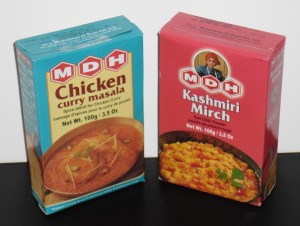
The MDH Chicken Masala makes a very quick curry that’s at least as good as you can get in a restaurant at a fraction of the price, so a very useful standby, to which I resort frequently. And if you’re not comfortable with having lots of individual spices around, the use for which you’re not sure of, it’s an easy solution to making a good curry.
There are a whole range of different spice mixes for different curries and they’re very cheap so have a good look at what’s available and buy a couple of others to try as well.
Get some and impress your family/friends
Monday 8 June 2015
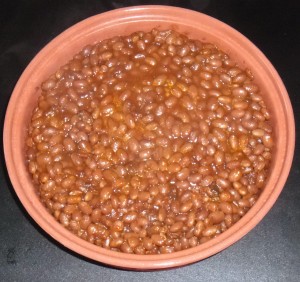
Barbecue Beans
I’ve long had a fascination with barbecue beans, a side dish commonly available in hamburger restaurants, and a kind of baked beans on steroids. They are available in tins from Heinz (usually small tins but I note recently that they now have large tins presumably for the summer season) but I’ve always had a hankering to make them.
I’ve tried various ways from simply squeezing bottled barbecue sauce into ordinary baked beans (which is actually OK) to doing the whole soak/cook/make thing with dried haricot beans (this weekend for Olivera’s barbecue yesterday result shown above), which was good but took an astonishing 8 hours of cooking to get the beans soft enough to eat.
Given that, my preferred method is to use the attached recipe but with tinned beans instead of dried ones – just make the sauce, tip in 3-4 drained tins of beans (and do drain them – you do not want to eat the liquid from the tins) and let them cook for an hour or so to let the sauce develop (longer is better for the sauce). Haricot beans are traditional but I quite like using a larger bean, either cannellini or pinto, which have a nice colour.
Also at the barbecue yesterday I produced some of my recently discovered no-churn ice cream and was asked to put the recipe on this site. I’m passionate about vanilla ice cream but less so about the palaver of using a double boiler to make an egg custard which is then churned/frozen to make an (admittedly) lovely ice cream so imagine my delight when I found a wonderfully easy alternative.
Do try this as it really is easy, produces a fabulous result, and is much cheaper than buying good-quality ready-made ice cream. For a splash of extra luxury have a go at the salted caramel version – also very easy and nothing like as daunting as it sounds.
Saturday 6 June 2015
As it’s the 70th anniversary of D-Day I’ve taken the liberty of adding a poem dedicated to this momentous event – BLOODY OMAHA
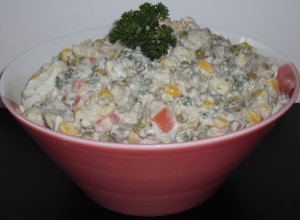
Russian Salad
I hate to think I might be starting another Cold War, but next time you’re tempted to make that great American classic Potato Salad, try a Russian Salad instead.
On a couple of occasions recently I have served this up as part of a meal to people who have never tried it, and both times at least one person at the table has declared it their favourite food.
There’s something perfect about Russian Salad as it seems to tick every food box – it’s easy to eat (not quite nursery food but heading in that direction); highly nutritious; lots of fibre; incredibly yummy, and seriously moreish (very difficult to stop eating it); and from the cook’s point of view, ever so simple.
It’s eaten all over Eastern Europe, hugely popular in Spain, whence it was carried to the New World, so appears all over Latin/South America. In a Tapas Bar where I meet a good friend every few weeks, I observed to a waitress that this was the only tapas bar I know NOT to have Russian Salad on the menu. Well, within a few weeks it was! Initially they made it with not just tuna but mashed up ‘boquerones’ (marinated fresh anchovies) as well. I was not keen on that and so next time we went, I declined the Russian Salad because of the boquerones, only to be told that they no longer added them as they themselves thought it didn’t work.
There are as many recipes for this dish as there are people who make it (and I understand from a recent Russian cookery program on TV that EVERY Russian family eats it and EVERY Russian cook has their own recipe. Interestingly (well, I think so), in Russia, it is known as Olivier Salad since it was created by the famous Belgian chef (not French à la Poirot!) Lucien Olivier, although his version apparently included grouse, tongue, caviar, crayfish tails and smoked duck, which makes my recipe but a pale shadow of his. At one time it was the most popular dish in Tsarist Moscow!
My friendly Spanish waitress told me that as long as it contains potatoes, eggs and mayonnaise, it can reasonably be called Russian salad, everything else being optional.
I couldn’t recommend having a go at it more highly – it’s fabulous.
Thursday 4 June 2015
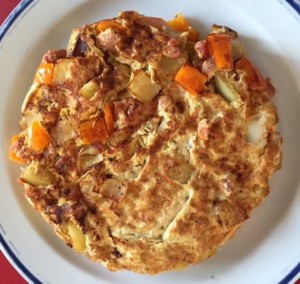
Western omelette
For cowboys, apparently the big difference between being on the trail with the ‘Chuck’ wagon and being back on the ranch was the availability of eggs. Not surprisingly chickens were not taken with them on the trail so while they may have had some eggs for the first few days of a roundup, after they had gone, the diet would consist of the inevitable beans with whatever the cook could knock up – this presumably being the difference between a good cook and an indifferent one.
But back on the ranch and all that changed with all kinds of exciting goodies turning up on the table, not the least of which was this kind of omelette containing easily available ingredients. Very much like a Spanish tortilla, it ticked lots of boxes like delicious, nutritious, easy, filling, etc. – many cowboys would be able to make it themselves.
For me it’s a useful standby which can be quickly and easily made if there’s not a lot of anything else available. Depending on how hungry you are, either scoff it straight from the pan with ketchup squeezed over it or turn it out onto a plate for a more genteel approach.
While the recipe given uses bacon, onion, peppers, potatoes and chilli, use more or less whatever is available, omitting meat if vegetarian. It never fails to delight.
Wednesday 3 June 2015 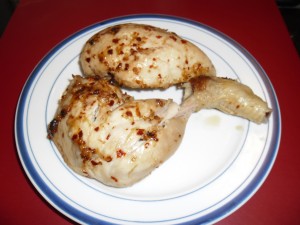
Piri-Piri chicken
My dear friend Olivera is having a barbecue on Sunday to celebrate her daughter’s birthday. I’ve done a couple of barbecues this year so far and had told Olivera that one of my favourite ways of doing chicken for a barbecue is piri-piri. She said she liked the sound of it and asked if I used a bottled piri-piri sauce, to which I replied that I (of course) did not.
I found this recipe on the internet (can’t remember exactly where) but it knocks spots off any other piri-piri chicken I’ve ever had. It’s dead easy, very quick and wonderful as part of a barbecue or just served for supper with some chips.
Ordinarily I would send Olivera the recipe but I decided on this occasion to dedicate the next page of my blog to her and her barbecue and place this recipe on there so she can find it any time she needs it (as she has a habit of losing the recipes I give her!) .

